每天推荐一个 GitHub 优质开源项目和一篇精选英文科技或编程文章原文,欢迎关注开源日报。交流QQ群:202790710;电报群 https://t.me/OpeningSourceOrg
今日推荐开源项目:《用Vue.js开发微信小程序——mpvue》
推荐理由:mpvue是一个使用 Vue.js 开发小程序的前端框架。框架基于 Vue.js 核心,mpvue 修改了 Vue.js 的 runtime 和 compiler 实现,使其可以运行在小程序环境中,从而为小程序开发引入了整套 Vue.js 开发体验。
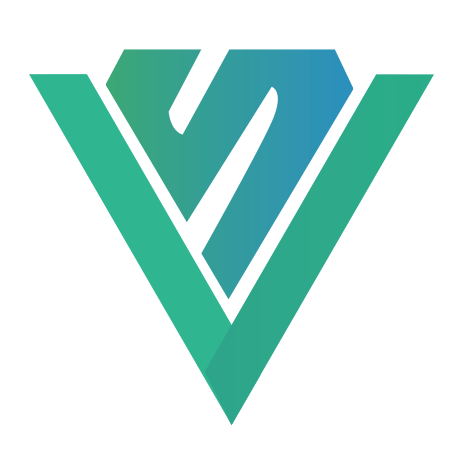
该框架有以下优点:
1.彻底的组件化开发能力:提高代码复用性
2.完整的 Vue.js 开发体验
3.方便的 Vuex 数据管理方案:方便构建复杂应用
4.快捷的 webpack 构建机制:自定义构建策略、开发阶段 hotReload
5.支持使用 npm 外部依赖
6.使用 Vue.js 命令行工具 vue-cli 快速初始化项目
7.H5 代码转换编译成小程序目标代码的能力
安装
首先,你需要已经安装微信开发者工具,链接:
https://mp.weixin.qq.com/debug/wxadoc/dev/devtools/download.html
其次,你需要安装node.js:
然后你应该能愉快的开始玩耍了
1.切换源
npm set registry https://registry.npm.taobao.org/
2. 全局安装vue-cli(vue 官方的一个命令行工具)
npm install --global vue-cli
3.创建新项目
vue init mpvue/mpvue-quickstart test
4.进入文件夹,安装依赖
cd testnpm installnpm run dev
成功的话,在test目录下应该能看见一个dist文件夹
当然,以上是快速搭建的方法,想要自行配置的同学请自行参考:
使用
打开你的

然后进入

目录请选择之前提到的那个dist文件夹
AppID影响能否真机调试
确定后,便能进入如下界面:
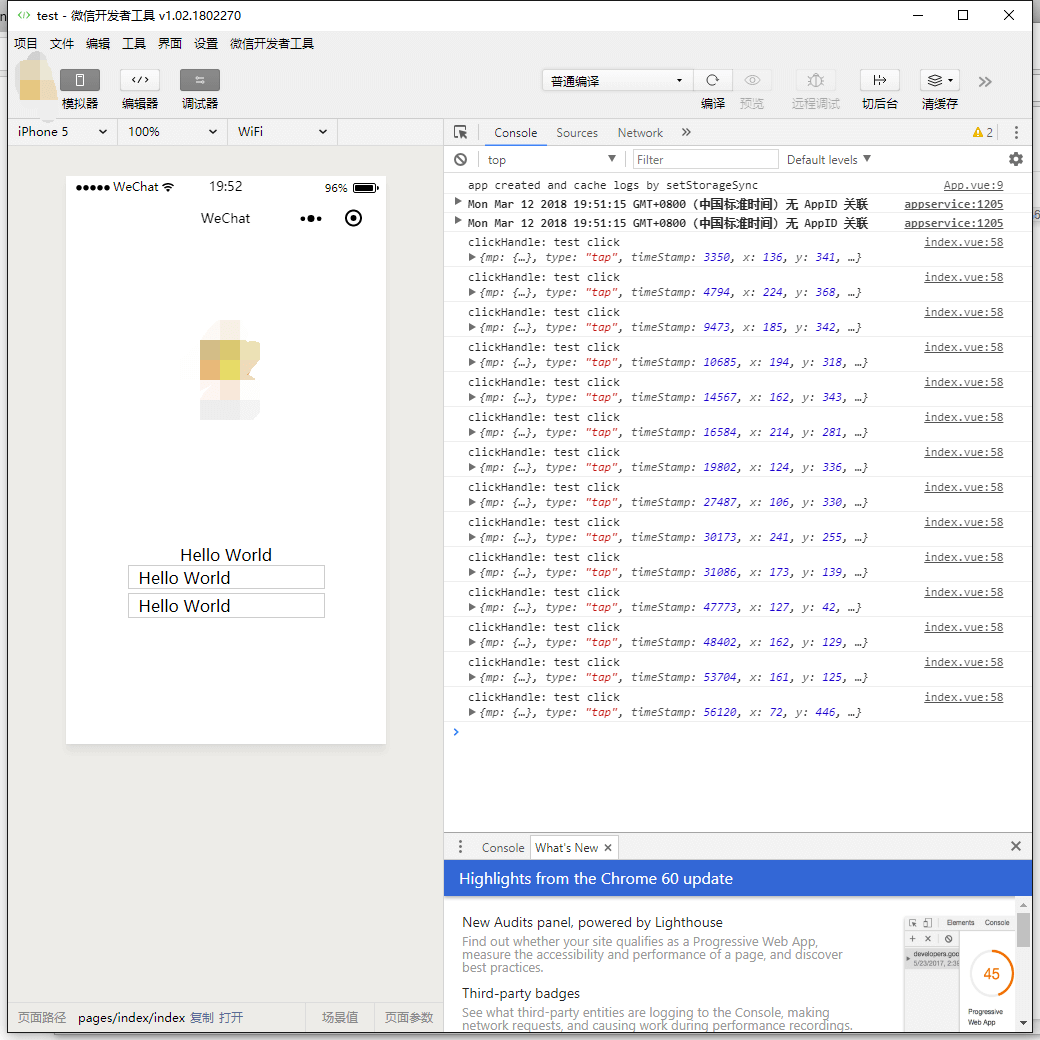
然后轻松愉快的用自己的方式打开src下的代码进行更改就ok了
mpvue是一个不错的框架,不论你是想玩一玩(例如我)还是进行开发都是不错的选择,vue的学习也不难,预测该项目下周还会在周榜上(笑)
你可能会用到的工具:
mpvue-loader 提供 webpack 版本的加载器:http://mpvue.com/build/mpvue-loader
mpvue-webpack-target webpack 构建目标:http://mpvue.com/build/mpvue-webpack-target
postcss-mpvue-wxss 样式代码转换预处理工具:http://mpvue.com/build/postcss-mpvue-wxss
px2rpx-loader 样式转化插件:http://mpvue.com/build/px2rpx-loader
mpvue-quickstart mpvue-quickstart:http://mpvue.com/mpvue/quickstart
mpvue-simple 辅助 mpvue 快速开发 Page / Component 级小程序页面的工具http://mpvue.com/mpvue/simple
关于webpack
该项目还十分贴心的配了一张图:
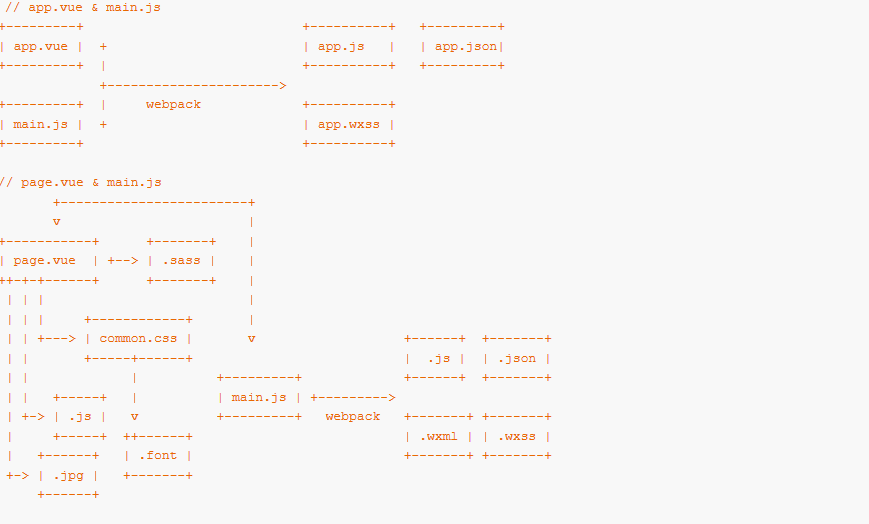
和webpack的文档链接:https://doc.webpack-china.org/
毕竟我也不了解,只能做到这了(笑)
作者背景简介
美团点评,隶属于一家大型(国内顶尖)的外卖——美团外卖。
今日推荐英文原文:《3 tips for organizing your open source project's workflow on GitHu》作者:
原文链接:https://opensource.com/article/18/4/keep-your-project-organized-git-repo
推荐理由:怎么能更好地在 GitHub 上组织你的开源项目的工作流程呢?这里有3个tips。
3 tips for organizing your open source project's workflow on GitHub
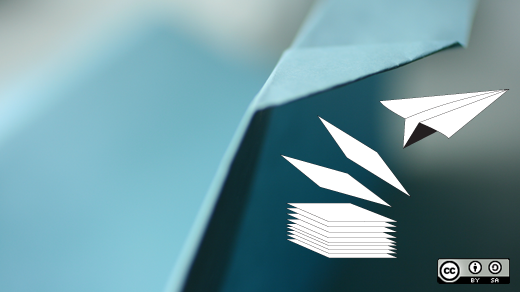
Managing an open source project is challenging work, and the challenges grow as a project grows. Eventually, a project may need to meet different requirements and span multiple repositories. These problems aren't technical, but they are important to solve to scale a technical project. Business process management methodologies such as agile and kanban bring a method to the madness. Developers and managers can make realistic decisions for estimating deadlines and team bandwidth with an organized development focus.
At the UNICEF Office of Innovation, we use GitHub project boards to organize development on the MagicBox project. MagicBox is a full-stack application and open source platform to serve and visualize data for decision-making in humanitarian crises and emergencies. The project spans multiple GitHub repositories and works with multiple developers. With GitHub project boards, we organize our work across multiple repositories to better understand development focus and team bandwidth.
Here are three tips from the UNICEF Office of Innovation on how to organize your open source projects with the built-in project boards on GitHub.
1. Bring development discussion to issues and pull requests
Transparency is a critical part of an open source community. When mapping out new features or milestones for a project, the community needs to see and understand a decision or why a specific direction was chosen. Filing new GitHub issues for features and milestones is an easy way for someone to follow the project direction. GitHub issues and pull requests are the cards (or building blocks) of project boards. To be successful with GitHub project boards, you need to use issues and pull requests.
github-open-issues.png
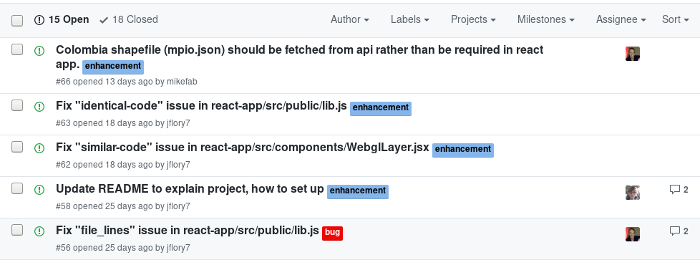
GitHub issues for magicbox-maps, MagicBox's front-end application.
The UNICEF MagicBox team uses GitHub issues to track ongoing development milestones and other tasks to revisit. The team files new GitHub issues for development goals, feature requests, or bugs. These goals or features may come from external stakeholders or the community. We also use the issues as a place for discussion on those tasks. This makes it easy to cross-reference in the future and visualize upcoming work on one of our projects.
Once you begin using GitHub issues and pull requests as a way of discussing and using your project, organizing with project boards becomes easier.
2. Set up kanban-style project boards
GitHub issues and pull requests are the first step. After you begin using them, it may become harder to visualize what work is in progress and what work is yet to begin. GitHub's project boards give you a platform to visualize and organize cards into different columns.
There are two types of project boards available:
- Repository: Boards for use in a single repository
- Organization: Boards for use in a GitHub organization across multiple repositories (but private to organization members)
The choice you make depends on the structure and size of your projects. The UNICEF MagicBox team uses boards for development and documentation at the organization level, and then repository-specific boards for focused work (like our community management board).
Creating your first board
Project boards are found on your GitHub organization page or on a specific repository. You will see the Projects tab in the same row as Issues and Pull requests. From the page, you'll see a green button to create a new project.
There, you can set a name and description for the project. You can also choose templates to set up basic columns and sorting for your board. Currently, the only options are for kanban-style boards.
github-project-boards-create-board.png
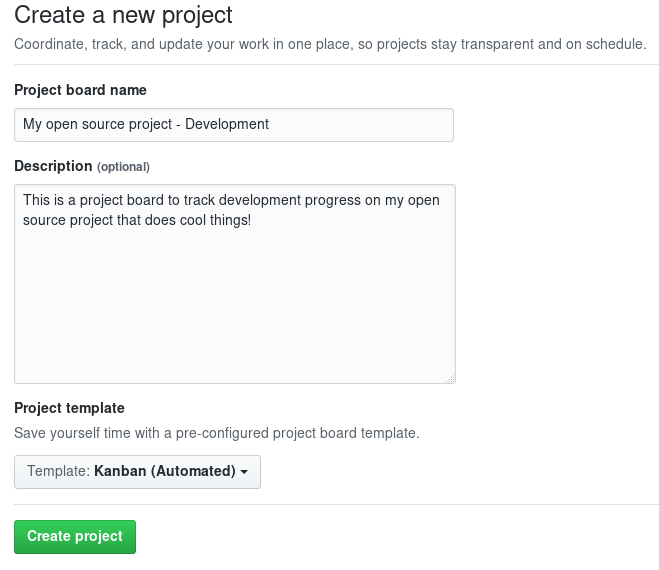
Creating a new GitHub project board.
After creating the project board, you can make adjustments to it as needed. You can create new columns, set up automation, and add pre-existing GitHub issues and pull requests to the project board.
You may notice new options for the metadata in each GitHub issue and pull request. Inside of an issue or pull request, you can add it to a project board. If you use automation, it will automatically enter a column you configured.
3. Build project boards into your workflow
After you set up a project board and populate it with issues and pull requests, you need to integrate it into your workflow. Project boards are effective only when actively used. The UNICEF MagicBox team uses the project boards as a way to track our progress as a team, update external stakeholders on development, and estimate team bandwidth for reaching our milestones.
github-issues-metadata.png
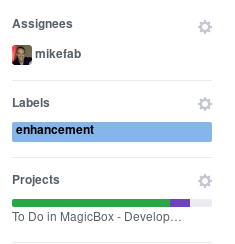
Tracking progress with GitHub project boards.
If you are an open source project and community, consider using the project boards for development-focused meetings. It also helps remind you and other core contributors to spend five minutes each day updating progress as needed. If you're at a company using GitHub to do open source work, consider using project boards to update other team members and encourage participation inside of GitHub issues and pull requests.
Once you begin using the project board, yours may look like this:
github-project-boards-overview.png
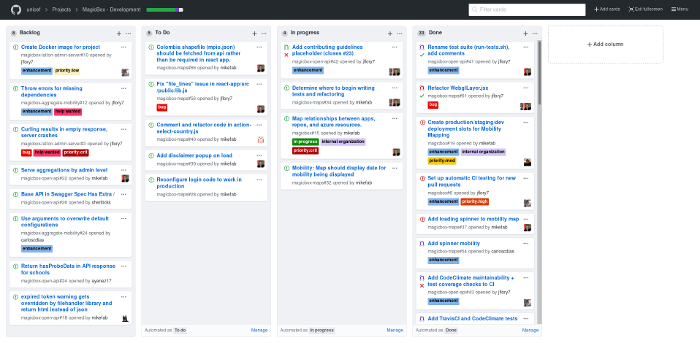
Development progress board for all UNICEF MagicBox repositories in organization-wide GitHub project boards.
Open alternatives
GitHub project boards require your project to be on GitHub to take advantage of this functionality. While GitHub is a popular repository for open source projects, it's not an open source platform itself. Fortunately, there are open source alternatives to GitHub with tools to replicate the workflow explained above. GitLab Issue Boards and Taiga are good alternatives that offer similar functionality.
Go forth and organize!
With these tools, you can bring a method to the madness of organizing your open source project. These three tips for using GitHub project boards encourage transparency in your open source project and make it easier to track progress and milestones in the open.
Do you use GitHub project boards for your open source project? Have any tips for success that aren't mentioned in the article? Leave a comment below to share how you make sense of your open source projects.
每天推荐一个 GitHub 优质开源项目和一篇精选英文科技或编程文章原文,欢迎关注开源日报。交流QQ群:202790710;电报群 https://t.me/OpeningSourceOrg
